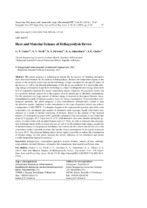| dc.contributor.author | Uzakov, G. N. | |
| dc.contributor.author | Novik, A. V. | |
| dc.contributor.author | Davlonov, X. A. | |
| dc.contributor.author | Almardanov, X. A. | |
| dc.contributor.author | Chuliev, S. E. | |
| dc.coverage.spatial | Минск | ru |
| dc.date.accessioned | 2023-02-09T13:19:37Z | |
| dc.date.available | 2023-02-09T13:19:37Z | |
| dc.date.issued | 2023 | |
| dc.identifier.citation | Heat and Material Balance of Heliopyrolysis Device = Тепловой и материальный баланс гелиопиролизного устройства / G. N. Uzakov [et al.] // Известия высших учебных заведений и энергетических объединений СНГ. Энергетика. – 2023. – № 1. – С. 57-65. | ru |
| dc.identifier.uri | https://rep.bntu.by/handle/data/126120 | |
| dc.description.abstract | The article proposes a technological scheme for the process of obtaining alternative fuels from local biomass by the method of heliopyrolysis. Besides, the temperature regime in the reactor of the pyrolysis device and the thermal energy savings consumed for the specific needs of the device, as well as the thermal performance of the device are analyzed. It is known that reducing energy consumption in pyrolysis technology is a major challenge because energy (heat) must first be supplied to maintain the reactor temperature regime. Typically, the processes carried out in a pyrolysis unit are carried out at the expense of coal, natural gas or electricity consumption. For the operation very large amount of thermal energy is required to decompose biomass waste, and additional heating of biomass requires excessive energy consumption. To prevent these technological problems, the article proposes a solar concentrator’s heliopyrolysis system to heat the pyrolysis reactor. Applying a solar concentrator to this type of pyrolysis device can achieve a temperature of 400–700 °C. A schematic diagram of the experimental pyrolysis unit of the solar concentrator was developed, and samples of alternative fuels (pyrogas, liquid, solid fuels) were obtained as a result of thermal processing of biomass. Based on the analysis of the material balance of a heliopyrolysis plant with a parabolic-cylindrical solar concentrator, it was found that about 20 % pyrogas, 60 % liquid fuel, 8–20 % solid alternative fuel were obtained during the pyrolysis of cotton stalks with an initial biomass load of 3.76 kg. In order to determine the consumption of thermal energy in the pyrolysis process, as well as for the replaced solar energy, an analysis of the heat balance of the proposed installation was carried out. It is shown that the use of a solar concentrator makes it possible to reduce the specific energy consumption for the pyrolysis process by up to 30 %. The proposed heliopyrolysis device makes it possible to reduce the consumption of thermal energy for own needs, increase the overall efficiency of the installation and ensure a stable temperature regime for pyrolysis. | ru |
| dc.language.iso | en | ru |
| dc.publisher | БНТУ | ru |
| dc.title | Heat and Material Balance of Heliopyrolysis Device | ru |
| dc.title.alternative | Тепловой и материальный баланс гелиопиролизного устройства | ru |
| dc.type | Article | ru |
| dc.identifier.doi | 10.21122/1029-7448-2023-66-1-57-65 | |
| local.description.annotation | Предложена технологическая схема процесса получения альтернативного топлива из местной биомассы методом гелиопиролиза. Проанализированы температурный режим в реакторе пиролизной установки, экономия тепловой энергии, расходуемой на конкретные нужды оборудования, а также тепловая производительность установки. Снижение энергопотребления в технологии пиролиза является серьезной проблемой. Это связано с необходимостью подвода энергии (теплоты) для поддержания температурного режима реактора, дополнительного нагрева биомассы, а также особенностями процесса разложения отходов, для которого требуется очень большая тепловая энергия. Обычно пиролиз осуществляется за счет потребления угля, природного газа или электроэнергии. В статье предложено использовать для обогрева пиролизного реактора гелиопиролизную систему с параболоцилиндрическим солнечным концентратором, что позволяет достичь температуры 400–700 °C. Разработана принципиальная схема экспериментальной пиролизной установки солнечного концентратора и получены образцы альтернативных топлив. Так, термическая переработка стеблей хлопчатника дала около 20 % пирогаза, 60 % жидкого топлива, 8–20 % твердого альтернативного топлива при загрузке исходной биомассы 3,76 кг. Рассмотрен тепловой и материальный баланс установки. Показано, что применение солнечного концентратора позволяет уменьшить удельные энергозатраты на процесс пиролиза до 30 %. Предложенная гелиопиролизная установка снижает расход тепловой энергии на собственные нужды, повышает общий коэффициент полезного действия и обеспечивает стабильный температурный режим пиролиза. | ru |

